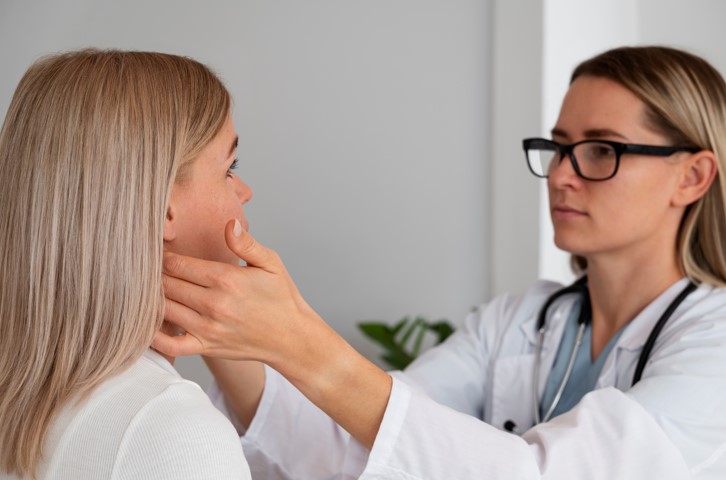
Source: FreePik
Thyroid eye disease (TED), also known as Graves’ ophthalmopathy or thyroid-associated orbitopathy, is a condition characterized by inflammation and swelling of the tissues around the eyes. It commonly affects individuals with thyroid disorders, particularly those with Graves’ disease, an autoimmune condition where the thyroid gland becomes overactive (hyperthyroidism). TED can cause a range of symptoms, from mild irritation to severe eye problems that may lead to vision loss if left untreated. This article aims to shed light on the symptoms, causes, and treatment options available for thyroid eye disease.
Symptoms of Thyroid Eye Disease
The symptoms of thyroid eye disease can vary widely among individuals and may include:
- Protruding or bulging eyes: One of the hallmark signs of TED is the protrusion of one or both eyes, also known as exophthalmos or proptosis. This occurs due to inflammation and swelling of the muscles and tissues behind the eyes, pushing them forward.
- Eye redness and irritation: Patients with TED often experience redness, itching, and irritation in the eyes. This may be accompanied by a gritty sensation, excessive tearing, or dryness.
- Double vision (diplopia): Inflammation of the muscles that control eye movement can lead to double vision, especially when looking in certain directions. This symptom can significantly impact daily activities such as reading or driving.
- Eye pain or pressure: Some individuals with thyroid eye disease may experience pain or pressure behind the eyes, which can be severe and debilitating.
- Swelling and inflammation: The eyelids and surrounding tissues may become swollen and inflamed, causing the eyes to appear puffy.
- Difficulty closing the eyes completely: In severe cases, TED can affect the function of the eyelids, making it difficult to fully close the eyes. This can lead to dryness and exposure of the cornea, increasing the risk of corneal damage and infection.
Causes of Thyroid Eye Disease
The exact cause of thyroid eye disease is not fully understood, but it is believed to be related to an autoimmune reaction in which the body’s immune system mistakenly attacks the tissues around the eyes. This autoimmune response is often triggered by underlying thyroid disorders, particularly Graves’ disease. In Graves’ disease, the immune system produces antibodies that stimulate the thyroid gland to produce excessive amounts of thyroid hormones, leading to hyperthyroidism. These same antibodies may also target the tissues around the eyes, causing inflammation and swelling.
Other factors that may contribute to the development of thyroid eye disease include smoking, which has been shown to worsen the condition and increase the risk of complications. Additionally, genetics may play a role, as thyroid disorders and autoimmune conditions tend to run in families.
Treatment
Treatment for thyroid eye disease aims to alleviate symptoms, reduce inflammation, and prevent complications. The choice of treatment depends on the severity of the condition and may involve a combination of medical, surgical, and supportive therapies. Some common treatment options include:
- Steroid therapy: Oral or intravenous corticosteroids may be prescribed to reduce inflammation and swelling in the tissues around the eyes. Steroids can help alleviate symptoms such as pain, redness, and swelling, but long-term use may be associated with side effects and requires careful monitoring by a healthcare provider.
- Immunosuppressive therapy: In cases where steroid therapy is ineffective or not well-tolerated, immunosuppressive medications such as methotrexate or cyclosporine may be recommended to suppress the immune response and reduce inflammation.
- Thyroid hormone therapy: Achieving stable thyroid hormone levels through medication or other treatments is essential for managing thyroid eye disease. Controlling hyperthyroidism can help prevent the progression of TED and improve outcomes.
- Radiotherapy: External beam radiotherapy may be considered in some cases to reduce inflammation and prevent further damage to the eyes. This treatment involves targeting low-dose radiation to the tissues around the eyes to suppress the immune response.
- Surgery: In severe cases of thyroid eye disease where conservative treatments are ineffective, a surgical intervention may be necessary to improve eye function and appearance. Surgical options may include orbital decompression surgery to relieve pressure on the eyes, strabismus surgery to correct double vision, or eyelid surgery to repair eyelid retraction or ptosis.
- Supportive therapies: In addition to medical and surgical treatments, supportive therapies such as artificial tears, lubricating eye gels, and protective eyewear may be recommended to relieve dryness, protect the cornea, and improve overall eye comfort.
Thyroid eye disease is a complex condition that requires comprehensive management by a multidisciplinary team of healthcare providers, including endocrinologists, ophthalmologists, and surgeons. Early diagnosis and appropriate treatment are crucial for minimizing symptoms, preventing complications, and preserving vision and eye function. By understanding the symptoms, causes, and treatment options available for thyroid eye disease, patients and healthcare providers can work together to develop an individualized treatment plan that addresses the unique needs of each patient.



Facebook Comments